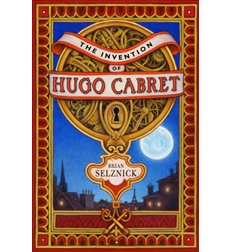The Weight of Hugo Cabret
 Yesterday I discussed how I think the illustrations and text of The Invention of Hugo Cabret work together cinematically, unlike pictures and words in picture books, traditionally illustrated novels, or comics. Today I'll discuss how well the book worked for me.
Yesterday I discussed how I think the illustrations and text of The Invention of Hugo Cabret work together cinematically, unlike pictures and words in picture books, traditionally illustrated novels, or comics. Today I'll discuss how well the book worked for me.
The story surely qualifies as a novel, but it's no more complex than a lot of other middle-grade fiction. As a story it's fine but not great. The prose is often prosaic, and not just because I see my least favorite word, “excitedly,” on page 115. The point of view can suddenly shift (“Isabelle's foot felt like it was broken,” page 298), and a French boy comes out with, “OK.”
I will here acknowledge the obvious, that the prose in Selznick's first novel is much better than my drawings will ever be. And those drawings do make The Invention of Hugo Cabret a more interesting project to study, both as a reader and as someone who works on books. As an object, the book is undeniably impressive.
In the end, however, I kept wondering whether this novel was worth its extra weight in paper. It's 300+ pages longer than a typical middle-grade, but the story didn't seem more full. Furthermore, that paper is extra-thick and extra-white to preserve the rich blacks of Selznick's art. The binding, Selznick said at this winter's SCBWI conference in New York, is an innovative type that lets the book lie flat, with nothing swallowed into the gutter (more like a movie screen).
All that paper produces a thick brick of a book. Both Hugo Cabret and Harry Potter and the Order of the Phoenix are 2.1 inches thick, according to Scholastic’s web catalog, and about the same weight. But HP5 is 870 pages, and Hugo Cabret 544. (The official page count is 533, but the real count must be divisible by 16.) That means the same shelf space contains two-thirds the number of pages for storytelling.
Furthermore, many of those pages are, as I discussed yesterday, pictures meant to be looked at for just a second. Some might say that each picture is worth a thousand words, but in this case a lot of the pictures repeat information because they're inspired by a cinematic model: one image zipping by after another. At the end, for example, there are fourteen pages of the Moon fading; those spreads produce an impression, to be sure, but they're not the informational equivalent of 7,000 words, or even fourteen book pages. All-black pages punctuate scenes, like a movie fading to black. Again, that storytelling technique works by evoking cinema, but it also adds to the book's heft without adding much to the content.
As a result, for me Hugo Cabret seemed a little inflated. I won't be surprised if Hugo Cabret becomes a landmark in book design and graphic storytelling, but I kept wondering if it will turn out to be a children's favorite.
(Despite its size, Hugo Cabret is not burdened with a high price. Its $22.99 is about two-thirds of the jacket price of Harry Potter and the Deathly Hallows for about two-thirds the pages. Looked at in another way, it's about the normal cost of an adult novel that's half as long. How is it economically possible for Scholastic to produce this book at that price? Hugo Cabret was printed in Singapore.)


4 comments:
I definitely agree with some of your musings, especially about how each spread only serves to be a fleeting moment of the narrative (and sometimes it does duplicate the text narration). However, I see that as serving the intent of the author/artist. This is what Selznick wished to achieve and I think he did admirably well. As to whether children respond well to this one -- THEY DO! Absolutely. My students all simply adore it.
And, by the way, this is by no means Selznick's "first novel" -- there were The Houdini Box and The Robot King prior to Hugo Cabret. There are common threads linking these three, as well.
Thanks for the correction on Selznick's past writing; I must have misheard his remarks in New York.
I agree that the cinematic/fleeting nature of the illustration is what Selznick wished to achieve. I guess my frugal heritage and experience in publishing makes me anxious about the use of so much paper!
I also agree with a lot of what you've said here. When you hear Selznick speak live about the book, what you're struck by primarily is just how amazing it is that he was able to write this book with so many influences and details and not end up with a big ole mess by the end. That said, the writing is fine but not extraordinary. The pictures, as you yourself said, fleeting. Compare it to Shaun Tan's, "The Arrival", where each picture demands that the viewer "read" it intently for at least 3 times as long as "Hugo Cabret". It would be lovely to see someone compare and contrast the two in terms of narrative storytelling. Which is to say, you.
Oh yet another intriguing book to read!
Looking at the webpage reminds me of reading Van Allsburg's The Mysteries of Harris Burdick.
Post a Comment